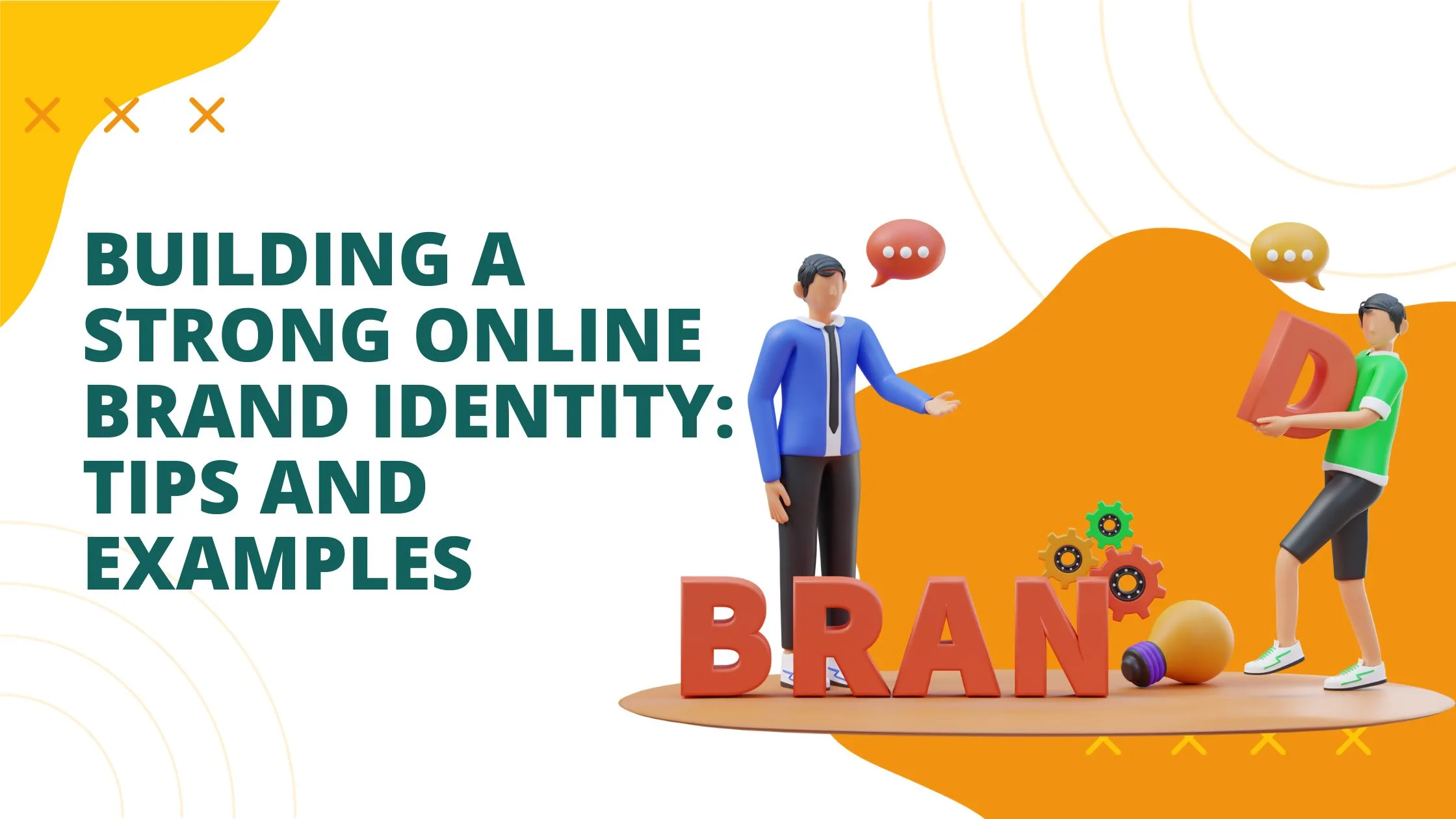Building a Strong Online Brand Identity: Tips and Examples
Are you ready to take your online presence to the next level? In today’s digital era, establishing a strong brand identity is crucial for success. Whether you’re an entrepreneur or a seasoned marketer, this blog post is here to guide you through the process of building an irresistible online brand.
From crafting compelling visuals to creating authentic messaging, we’ll dive into expert tips and real-life examples that will leave a lasting impression on your audience. Get ready to unleash your creativity and make waves in the vast ocean of cyberspace!
Introduction to Online Brand Identity
In today’s digital age, having a strong online brand identity is crucial for any business or individual looking to establish their presence and stand out in the competitive online market. With the increasing use of social media platforms and the rise of e-commerce, building a recognizable and consistent brand identity has become essential for success.
Online brand identity refers to how a brand is perceived by its target audience in the digital space. It encompasses all aspects of a brand’s online presence, including its website design, visual elements, messaging, tone of voice, and overall personality. In simpler terms, it is what sets your brand apart from others and makes it easily recognizable to your audience.
Why Is Online Brand Identity Important?
There are several reasons why having a strong online brand identity is crucial for businesses:
1. Builds Trust: A well-defined and consistent online brand identity helps build trust with your target audience. When people see your logo or come across your social media posts consistently, they begin to recognize you as an established and reliable brand.
2. Creates Differentiation: In today’s overcrowded marketplace where competition is fierce, having a unique and memorable brand identity can help you stand out from the crowd. It allows you to differentiate yourself from other businesses offering similar products or services.
3. Increases Brand Awareness: An effective online brand identity strategy can significantly increase your reach and visibility in the digital world. With more people recognizing your branding elements such as logos or color schemes, you can expand your customer base and attract new leads.
How to Establish an Online Brand Identity?
1. Define Your Brand’s Core Values and Mission: The first step in establishing an online brand identity is defining what your brand stands for. What values do you want to be associated with? What is your mission or purpose? This will help guide all your branding decisions and ensure consistency across all platforms.
2. Know Your Target Audience: Understanding your target audience is crucial when it comes to creating a strong online brand identity. Conduct market research, gather data, and analyze customer behavior to determine who you are trying to reach and what messaging will resonate with them.
Importance of a Strong Online Brand Identity
In today’s digital age, having a strong online brand identity has become more important than ever before. With the increasing reliance on technology and the internet, consumers are constantly engaging with brands online. This makes it crucial for businesses to establish a powerful and distinct online brand identity that sets them apart from their competitors.
But what exactly is an online brand identity? Simply put, it is the image or personality of your brand as perceived by your target audience in the digital space. It encompasses everything from your website design and social media presence to your content and customer interactions.
Understanding Your Target Audience
One of the key components of building a strong online brand identity is understanding your target audience. Without a clear understanding of who your target audience is, it can be difficult to create a brand that resonates with them and ultimately leads to success.
Identifying and understanding your target audience involves more than just knowing basic demographics such as age, gender, and income level. It requires delving deeper into their behaviors, interests, values, and pain points. This will help you create a brand that not only appeals to them but also solves their problems or meets their needs.
So how do you go about understanding your target audience? Here are some tips:
1. Conduct Market Research:
The first step in understanding your target audience is conducting market research. This can include surveys, focus groups, or even analyzing data from social media platforms or website analytics. The goal of market research is to gather insights about your potential customers’ preferences, behaviors, and motivations.
2. Create Buyer Personas:
After gathering data from market research, the next step is to create buyer personas – fictional representations of your ideal customers based on common characteristics found in your research. These personas should include details such as age, occupation, goals, challenges, interests, and preferred communication channels.
Defining Your Brand Personality and Values
Your brand’s personality and values are the backbone of your online identity. They are what sets you apart from your competitors and attracts potential customers to engage with your brand. In order to build a strong online brand identity, it is crucial to define and understand your brand’s personality and values.
Brand Personality
Just like individuals, brands also have unique personalities that reflect their characteristics, values, and tone of voice. Your brand personality should be consistent across all online channels – from social media posts to website content. This helps create a cohesive and memorable image for your audience.
To define your brand personality, start by identifying the key adjectives that best describe your brand. Is it playful or serious? Sophisticated or down-to-earth? These words will serve as the foundation of your brand’s character.
Next, think about how you want your target audience to perceive your brand. Do you want them to see it as innovative and modern or traditional and reliable? Your chosen perception should align with both your target market’s preferences and the products/services you offer.
It can also be helpful to identify a few well-known brands that have a similar personality to yours. This can give you inspiration on how they communicate their message through visuals, language, and overall branding.
Once you have defined your brand’s personality, it is important to stay consistent in its application across all aspects of branding – from color schemes to messaging.
Brand Values
Your brand values are the guiding principles that define what your brand stands for. They represent the beliefs and convictions that drive your brand’s decision-making process and actions.
To identify your brand values, think about what is important to you as a business owner and to your target audience. These values should align with your brand’s mission and vision. For example, if you are a sustainable fashion company, some of your values may include environmental responsibility, ethical sourcing, and transparency.
It can also be helpful to involve your team in identifying these values, as they are likely to have their own perspectives on what makes your brand unique.
Once you have determined your brand values, make sure to communicate them clearly and consistently through all of your online channels. This will help build trust with potential customers who share similar values.
Overall, defining your brand personality and values is an essential step in building a strong online identity. It not only helps differentiate your brand from competitors but also creates a connection with potential customers who align with your core beliefs and characteristics. By staying consistent in portraying these elements across all online channels, you can establish a memorable and authentic brand identity that resonates with your target audience.
Designing a Visual Identity (logo, color scheme, fonts)
When it comes to building a strong online brand identity, one of the most crucial elements is designing a visual identity that effectively represents your brand. This includes creating a logo, choosing a color scheme, and selecting appropriate fonts. In this section, we will discuss some important considerations for each of these components.
Logo Design:
Your logo is often the first thing your audience sees and remembers about your brand. It should be unique, memorable, and representative of your brand’s values and personality. When designing a logo for your online brand identity, here are some tips to keep in mind:
1. Keep it simple: A cluttered or complex logo can be overwhelming and difficult to remember. Aim for simplicity in both design and concept.
2. Make it versatile: Your logo should look good on various platforms such as social media profiles, website header, business cards, etc.
3. Consider colors carefully: The colors you choose for your logo can convey different emotions and associations to your audience. For example, red is associated with energy and excitement while blue conveys trustworthiness and professionalism.
4. Be consistent with branding elements: Your logo should align with the overall aesthetic of your website and other branding elements such as fonts and color scheme.
Color Scheme:
The colors you use throughout your website play a significant role in establishing your brand’s visual identity. Colors evoke emotions and create associations; therefore, it is essential to choose them carefully. Here are some tips for selecting a color scheme for your brand:
1. Start with brand values: Consider what emotions and values you want to convey through your brand. For example, if you want to communicate innovation and creativity, bright and bold colors may be appropriate.
2. Limit the number of colors: Too many colors can be overwhelming and distracting. Stick to a maximum of 3-4 complementary colors.
3. Consider color psychology: Different colors have different psychological effects on people. Do some research on color psychology and choose colors that align with your brand’s message.
4. Choose accessible colors: Make sure the color scheme you choose is accessible to all individuals, including those with color vision deficiencies.
Fonts:
The fonts you use can greatly impact the overall aesthetic of your website and contribute to your brand’s visual identity. Here are some things to consider when choosing fonts for your online brand:
1. Be consistent: It’s important to use the same fonts throughout your website as this creates a cohesive look and strengthens your branding.
2. Consider readability: Fonts that are difficult to read can be frustrating for users and may lead them to leave your site.
3. Match font style with brand personality: Just like colors, fonts also have their own personalities.
Creating Consistent Messaging Across Platforms
A strong online brand identity is not just about having a visually appealing website or social media presence. It also involves creating consistent messaging across all platforms to effectively communicate your brand’s values, mission, and voice. In today’s digital world, where consumers have multiple touchpoints with a brand, it is crucial to maintain consistency in your messaging to build trust and loyalty among your audience.
Here are some essential tips for creating consistent messaging across platforms:
1. Define Your Brand Voice and Values
The first step in developing a consistent message is to define your brand’s unique voice and core values. Your voice should reflect the personality of your brand and resonate with your target audience. Are you fun and playful or serious and professional? What are the key values that guide your business? Understanding these aspects will help you create a tone of voice that remains consistent across all platforms.
2. Use Visual Elements Consistently
In addition to verbal communication, visual elements such as logos, colors, fonts, and imagery play a significant role in reinforcing your brand identity. Make sure these elements are used consistently across all platforms to create a cohesive look and feel for your brand. This will help customers recognize your brand quickly and build trust over time.
3. Maintain Brand Guidelines
Having clear guidelines for how your branding should be used ensures consistency across all channels – from social media posts to website design. This includes everything from logo placement, color palette, font usage, image style, tone of voice guidelines , and more. Share these guidelines with all team members responsible for creating content to ensure everyone is on the same page.
4. Tailor Your Message for Each Platform
While maintaining consistency in your messaging is essential, it’s also crucial to adapt your message to each platform’s unique format and audience. For example, the tone and style of a post on Twitter may differ from that of a blog post or an email newsletter. However, the core message and values should remain consistent.
5. Be Authentic and Transparent
Consistent messaging is not just about using the same words or visuals across platforms; it’s also about authenticity and transparency. Be genuine in your communication with your audience and avoid misleading or contradictory messages. This will help build trust and credibility with your customers.
6. Monitor Your Messaging Across Platforms
Regularly monitor your messaging across all platforms to ensure consistency. This includes reviewing social media posts, website content, email newsletters, advertising campaigns, etc. If you notice any discrepancies or inconsistencies, take corrective action immediately.
In conclusion, creating consistent messaging across platforms requires a clear understanding of your brand voice, values, and guidelines. By following these tips, you can effectively communicate your brand’s identity and establish a strong connection with your audience across all digital
Utilizing Social Media to Strengthen Your Brand Identity
Social media has become an essential tool for businesses of all sizes to connect with their target audience and establish a strong brand identity. With billions of active users, platforms like Facebook, Instagram, Twitter, and LinkedIn offer businesses the opportunity to reach a wide range of potential customers.
In this digital age, having a strong presence on social media is crucial for building your brand’s online identity. It not only helps you reach a larger audience but also allows you to engage with them in real-time, which can greatly impact your brand perception. Here are some key ways to utilize social media to strengthen your brand identity:
1. Define Your Brand Voice and Tone
Before jumping into creating content for social media, it is important to define your brand voice and tone. Your brand voice should be consistent across all social media channels and align with your overall branding strategy. It should reflect the personality of your brand and resonate with your target audience.
For example, if you are a fun and playful fashion brand targeting young adults, then using casual language and incorporating humor into your posts would be appropriate. On the other hand, if you are a luxury skincare brand targeting affluent individuals, maintaining a sophisticated tone would be more suitable.
2. Consistency is Key
Consistency is crucial when it comes to building a strong online brand identity through social media. This includes posting regularly, using similar visuals/colors/fonts across all platforms and maintaining the same messaging style throughout.
Examples of Successful Online Brand Identities
In today’s digital age, having a strong online brand identity is crucial for businesses to stand out and succeed. A well-defined brand identity can help a company build credibility, establish a loyal customer base, and differentiate itself from competitors. To better understand the concept of online brand identity, let’s take a look at some successful examples.
1. Nike
Nike is one of the most recognizable and successful brands in the world, both offline and online. Their online brand identity is built on their slogan ‘Just Do It’ which encourages customers to push themselves to achieve their goals. This message is consistently reflected in all of their marketing campaigns, social media posts, website design, and even their packaging.
Additionally, Nike has successfully utilized influencer collaborations to further strengthen its online brand identity. By partnering with athletes and celebrities who embody the spirit of their brand, Nike reaches a wider audience while staying true to its core values.
2. Glossier
Glossier is another great example of a strong online brand identity. The beauty company focuses on natural beauty and self-acceptance rather than promoting an unrealistic standard of perfection. This message resonates with its target audience – young women – who are seeking authenticity in the products they use.
Glossier’s clean and minimalistic branding extends to their social media presence as well. They often feature user-generated content on Instagram that showcases real people using their products, creating a sense of community among followers.
– Analysis and Explanation of their Strategies
In the digital age, having a strong online brand identity is crucial for businesses to succeed. A well-crafted online brand can not only attract potential customers but also establish trust and credibility with existing ones. However, building an effective online brand identity requires more than just a catchy logo or a beautiful website. It involves carefully strategizing and implementing various methods to create a cohesive and impactful presence in the virtual world.
In this section, we will delve into the analysis and explanation of successful strategies that have been used by some of the top brands to build a strong online presence.
1. Consistency is Key:
Consistency is one of the most important elements when it comes to building an effective online brand identity. This means maintaining consistency in all aspects of your brand – from visuals and messaging to tone and voice. Brands like Coca-Cola and Nike are prime examples of consistency in their branding efforts. They have maintained their iconic logos, slogans, and overall aesthetic throughout their marketing campaigns, creating a recognizable image for consumers.
2. Know Your Target Audience:
To build a strong online brand identity, it’s crucial to understand who your target audience is and tailor your branding efforts accordingly. Conduct thorough market research to identify your ideal customer’s demographics, behaviors, interests, etc., and use this information to craft messaging that resonates with them. For instance, skincare brand Glossier has successfully built its online presence by targeting millennial women through its minimalist packaging, social media presence, and relatable messaging.
Common Mistakes to Avoid in Building an Online Brand Identity
Building a strong online brand identity is crucial for any business or individual looking to establish a successful presence on the internet. However, it’s easy to make mistakes when it comes to creating an effective and impactful brand identity. In this section, we will discuss some common mistakes that individuals and businesses should avoid in order to build a strong online brand identity.
1. Neglecting Your Brand’s Story and Values
One of the biggest mistakes in building an online brand identity is not having a clear understanding of your brand’s story and values. Your brand’s story is what sets you apart from your competitors and helps consumers connect with your business on a deeper level. Without a compelling story or set of values, your brand can come across as generic and unappealing.
To avoid this mistake, take the time to define your brand’s story and values before establishing an online presence. This will ensure that all aspects of your branding – from website design to social media content – are aligned with your narrative and values.
2. Inconsistent Visuals
Another common mistake is using inconsistent visuals across different platforms or channels. Your visual branding elements such as logo, color scheme, typography, and imagery should be consistent throughout all online touchpoints. Inconsistency can confuse consumers and weaken their perception of your brand.
To maintain consistency in visual branding, create style guides or templates that outline how these elements should be used on different platforms. This will help ensure that all marketing materials have a cohesive look and feel.
Conclusion:
In today’s digital age, having a strong online brand identity is crucial for the success of any business. It not only helps you stand out from the competition but also builds trust and credibility with your target audience. In this blog post, we have discussed various tips and examples to help you build a strong online brand identity.
Firstly, it is important to define your brand’s values, mission, and vision. This will serve as the foundation for your online presence and help guide all your branding efforts. Make sure to clearly communicate these values in all aspects of your online presence, including your website, social media profiles, and content.
Secondly, consistency is key when it comes to building an online brand identity. Your visual elements such as logo, color scheme, font choices should be consistent across all platforms. This creates a cohesive look and makes it easier for customers to recognize and remember your brand.





